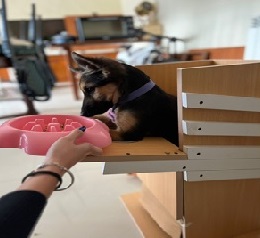Lead intoxication in two canines. Biochemical confirmation, specific treatment and review of most reported organic alterations in Veterinary Medicine
Keywords:
Lead intoxication, toxicologic urgencies, Calcium disodium edetate, Heavy metalsAbstract
Pet poisoning in veterinary medicine occurs relatively often, although it represents a small percentage of the wide variety of pathological entities the general
practitioner faces in daily practice (bacterial, parasitic, metabolic, traumatic, surgical). In turn, within toxic etiologies, those produced by heavy metals are rarely
reported today (in order of importance, poisonings produced by warfarinrodenticides, pesticides, human use medications, toxins, garbage, veterinary use
medications, toxic plants and foods are described). This report describes two cases of patients that suffered lead poisoning, presenting practically all the clinical signs historically reported by available literature. Despite being a scarcely frequent entity due to the heavy metal’s low availability, we consider that having knowledge aboutthe systems that are affected by such exposure, both chronically and acutely, is very important, irrespective of whether they are chronic or acute, since there arealterations that are lethal, and which when recognized in time, enable making a definite biochemistry diagnosis and establishing a specific healing treatment. But the potential sequels that such poisoning can leave, as well as its specific treatment must not be overlooked. To such end, the need to have veterinarian toxicological laboratories and suitable advising lines in place is emphasized.
Downloads
References
2. Giannuzzi L. Toxicologí a General y Aplicada. Facultad de Ciencias Exactas.Editorial de la Universidad de la Plata. 2018.
3. Guitart R, Manosa S, Guerrero X, Mateo R. Animal poisonings: the 10- YearExperience of a Veterinary Analytical Toxicology Laboratory. Vet. Hum. Tax.1999 Oct, 41(5): 331-335.PMID: 10509442.
4. Hoff B, Boerman HJ, et al. Retrospective study oftoxic metal analysesrequested at a veterinary diagnostic toxicology laboratory in Ontario (1990-
1995). Can. Vet. J. 1998,39: 39-43.9https://www.ncbi.nlm.nih.gov/pmc/articles/PMC1539835/
5. Morgan RV, Pearce LK, et al. Demographic data and treatment of smallcompanion animals with lead poisoning: 347 cases (1977-1986). JAVMA
[Internet]1991 [ consultado Abril 2023] Jul-l ,Vol 199. Disponible en:https://pubmed.ncbi.nlm.nih.gov/1909308/
6. Berny PH, Cote LM, Buck WB. Case reports of lead poisoning in dogs from theNational Animal Poison Control Center and the Centre NationalD'Informations Toxicologiques Veterinaries: Anecdotes or reality? Vet. Hum.Tax. 1992 Feb, 34(1): 26-31.
7. Bratton GR, KowaJczyk DF. Lead poisoning. En: Kirk R. (Ed): Currentveterinary therapy (X), Saunders Philadelphia, 1989: 152-159.
8. Hamir AN. Review oflead poisoning in dogs. Vet. Bull. 1986, 56: 1059-1070.
9. Boletí n de Antí dotos de Catalun a, Vol. 1 (2) junio – septiembre. 2018.https://medicaments.gencat.cat/ca/professionals/butlletins/Boletin-deAntidotos-deCataluna/
10. Ibim SE, Trotman J, Musey PI, Semafuko WE. Depletion of essential elementsby calcium disodium EDTA treatment in the dog. Toxicology.1992;73(2):229-37. DOI: 10.1016/0300-483x(92)90105-n. PMID: 1609432
11. Tusell Monso JM, Prandi Chevalier D, Ruiz de Gopegui.R. Intoxicacio n Agudapor plomo en el perro: Caso Clí nico. AVEPA. [Internet] 2001 [consultado
Abril 2022] Vol. 21 (1). Disponible en:https://ddd.uab.cat/pub/clivetpeqani/11307064v21n1/11307064v21n1p37.pdf
12. Rudorf H, Barr FJ, Lane JG. The role of ultrasound in the assessment oflaryngeal paralysis in the dog. Vet Radiol Ultrasound. 2001 JulAug;42(4):338-43. DOI: 10.1111/j.1740-8261.2001.tb00949.x.
13. Myerson MC. Paralysis of the larynx due to lead poisoning: including acontradiction of “Semons Law”. Arch Otolaryngol. 1934;20(5):659–664.
doi:10.1001/archotol.1934.03600050046003
14. Allen KJ. Case Report: Laryngeal paralysis secondary to lead toxicosis.Equine vet. Educ. (2010) 22 (4) 182-186. DOI: 10.1111/j.2042-3292.2010.00057.x
15. Summers BA, CummingsJF, de Lahunta A. Diseases of the peripheral nervoussystem. In: Veterinary Neuropathology. 1995, Eds: Mosby, St. Louis. Pp 402-502.
16. Audesirk G. Effects of lead exposure on the physiology of neurons. Prog.Neurobiol. 1985. 24, 199-231.
17. Helga R, Høga sen RO, Knutsen HK, Bernhoft A. Lead intoxication in dogs: riskassessment of feeding dogs trimmings of lead-shot game. BMC VeterinaryResearch (2016) 12:152, DOI: 10.1186/s12917-016-0771-z
18. Sacha Mace G, Shelton D, Eddlestone S. Megaesophagus. Vetlearn.com.Compendium: Continuing Education for Veterinarians. February 2012.
Declaraciones de autores: Silvina Sixto fue la derivante que recibió el caso clínico y realizo los tratamientos y seguimientos pertinentes. Gasto n Finucci Curi fue
interconsultado por la derivante por la posibilidad de existir contacto con el toxico descripto. Adema s, participo en la búsqueda bibliográfica y redacción del escrito . Juan Manuel Guevara realizo los me todos complementarios ecográfico e interpretación radiográfica e indico parte de la terapéutica realizada y seguimiento médico, adema s participo en la búsqueda bibliográfica, redacción y diseño del reporte.
Conflicto de intereses: No hay conflicto de interés de parte de ninguno de los autores/as del reporte.
Agradecimientos: A nuestras respectivas familias

Downloads
Published
How to Cite
Issue
Section
License
Copyright (c) 2024 Juan Manuel Guevara, S Sixto, G Finucci Curi

This work is licensed under a Creative Commons Attribution-NonCommercial-ShareAlike 4.0 International License.
Al momento de enviar sus contribuciones, los colaboradores deberán declarar , de manera fehaciente, que poseen el permiso del archivo o repositorio donde se obtuvieron los documentos que se anexan al trabajo, cualquiera sea su formato (manuscritos inéditos, imágenes, archivos audiovisuales, etc.), permiso que los autoriza a publicarlos y reproducirlos, liberando a la revista y sus editores de toda responsabilidad o reclamo de terceros , los autores deben adherir a la licencia Creative Commons denominada “Atribución - No Comercial CC BY-NC-SA”, mediante la cual el autor permite copiar, reproducir, distribuir, comunicar públicamente la obra y generar obras derivadas, siempre y cuando se cite y reconozca al autor original. No se permite, sin embargo, utilizar la obra con fines comerciales.


4.png)


7.png)



